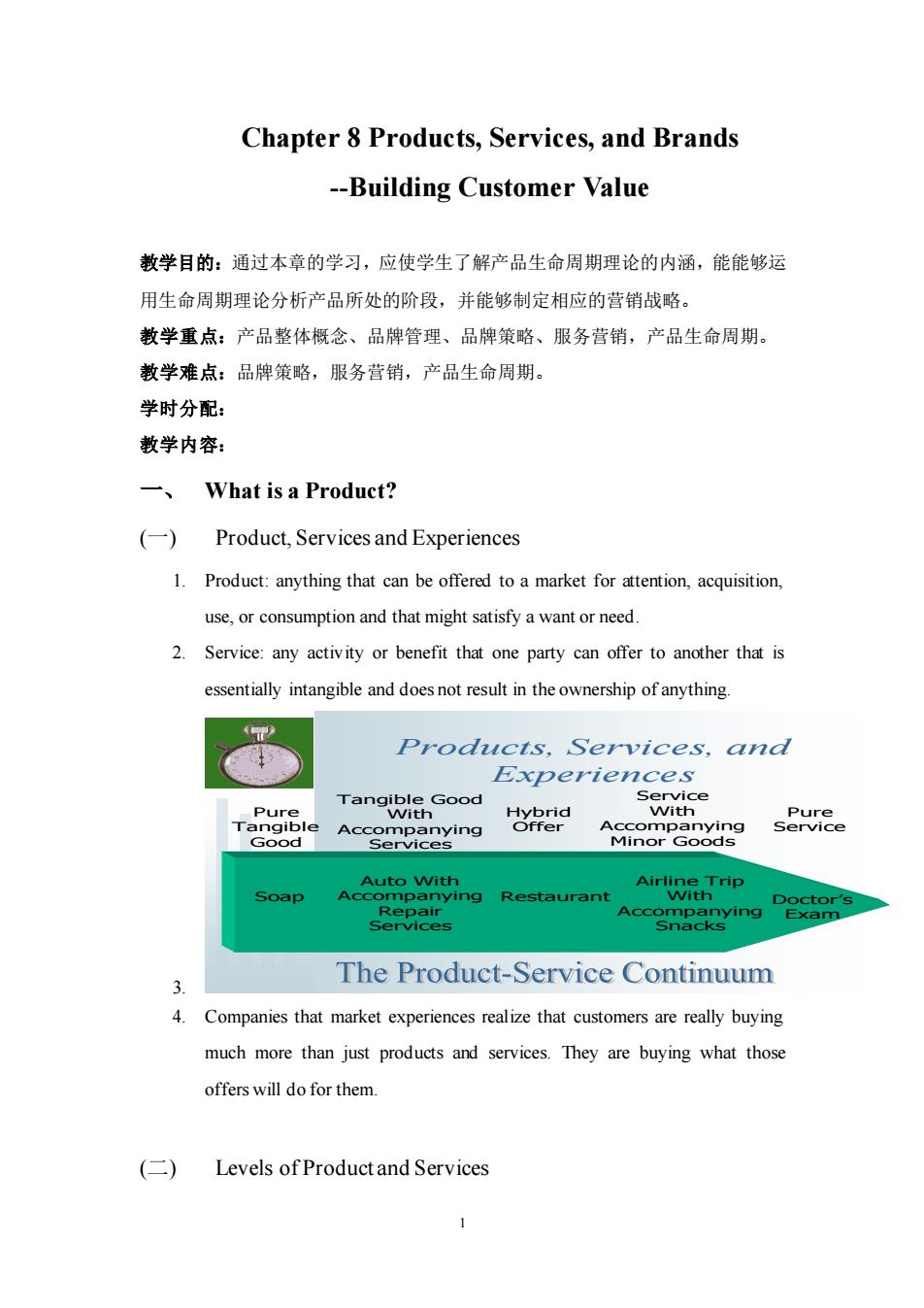
Chapter 8 Products,Services,and Brands -Building Customer Value 教学目的:通过本章的学习,应使学生了解产品生命周期理论的内涵,能能够运 用生命周期理论分析产品所处的阶段,并能够制定相应的营销战略。 教学重点:产品整体概念、品牌管理、品牌策略、服务营销,产品生命周期。 教学难点:品牌策略,服务营销,产品生命周期。 学时分配: 教学内容: -、What is a Product? (一) Product,Services and Experiences 1.Product:anything that can be offered to a market for attention,acquisition, use.or consumption and that might satisfy a want or need 2.Service:any activity or benefit that one party can offer to another that is essentially intangible and does not result in the ownership of anything. Products,Services,and Experiences TangiNicnGood Good Minor Goo Auto With Tric Soap mpanying Restaurant services The Product-Service Continuum 4.Companies that market experiences realize that customers are really buying much more than just products and services.They are buying what those offers will do for them. (Levels of Productand Services
1 Chapter 8 Products, Services, and Brands -Building Customer Value 教学目的:通过本章的学习,应使学生了解产品生命周期理论的内涵,能能够运 用生命周期理论分析产品所处的阶段,并能够制定相应的营销战略。 教学重点:产品整体概念、品牌管理、品牌策略、服务营销,产品生命周期。 教学难点:品牌策略,服务营销,产品生命周期。 学时分配: 教学内容: 一、 What is a Product? (一) Product, Services and Experiences 1. Product: anything that can be offered to a market for attention, acquisition, use, or consumption and that might satisfy a want or need. 2. Service: any activity or benefit that one party can offer to another that is essentially intangible and does not result in the ownership of anything. 3. Products, Services, and Experiences Pure Tangible Good Pure Service Soap Tangible Good With Accompanying Services Auto With Accompanying Repair Services Hybrid Offer Restaurant Service With Accompanying Minor Goods Airline Trip With Accompanying Snacks Doctor’s Exam 4. Companies that market experiences realize that customers are really buying much more than just products and services. They are buying what those offers will do for them. (二) Levels of Product and Services
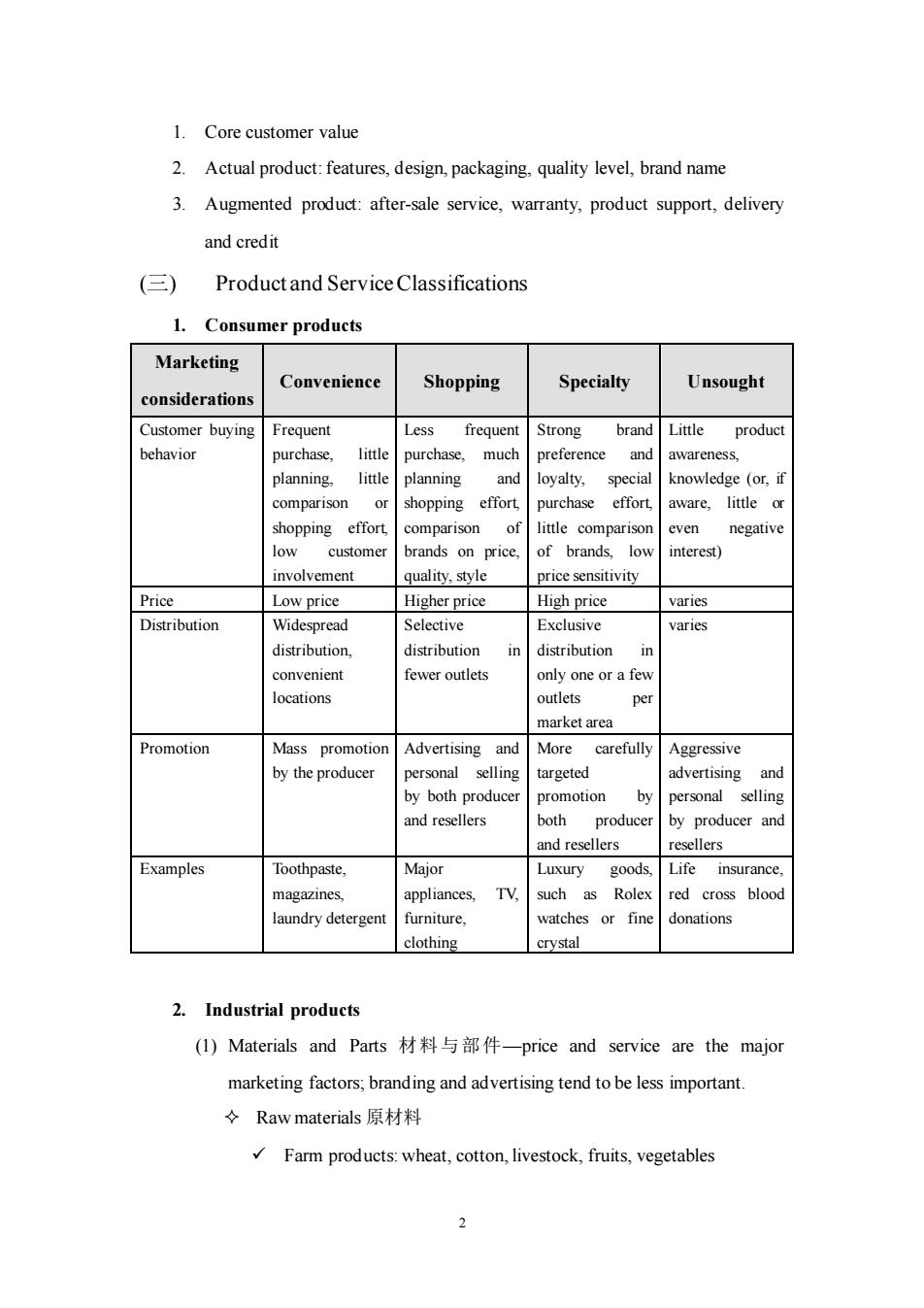
1.Core customer value 2.Actual product:features,design,packaging.quality level,brand name 3.Augmented product:after-sale service,warranty,product support,delivery and credit (三) Product and ServiceClassifications 1.Consumer products Marketing Convenienc considerations Shopping Specialty Unsought Customer buying Frequent Less frequent Strong brand Little product behavior purchase. little purchase.much preference and awareness. planning. little planning and lovalty. special knowledge (or,if comparison shopping effort purchase effort aware,little or shopping effort comparison e comparis even negative custome brands on price. of brands, interest) involvement quality.stvle price sensitivity Price Low price Higher price High price varies Distribution Wides ead Selective Exclus ive varies distribution distribution distribution convenient fewer outlets only one or a few 1ocat山ons outlets pe market area Promotion Mass promotion Advertising and More carefully Aggressive by the producer person targeted advertising by both produce promotion 6 personal selling and resellers both producer by producer and and resellers resellers Examples Toothpaste Maior Luxury goods, Life insurance appliances. such as Role red cross bloo aundry detergent furniture, watches or Tin donations clothing crystal 2.Industrial products (I)Materials and Parts材料与部件一price and service are the major marketing factors,branding and advertising tend to be less important 令Raw materials原材料 Farm products:wheat,cotton,livestock,fruits,vegetables
2 1. Core customer value 2. Actual product: features, design, packaging, quality level, brand name 3. Augmented product: after-sale service, warranty, product support, delivery and credit (三) Product and Service Classifications 1. Consumer products Marketing considerations Convenience Shopping Specialty Unsought Customer buying behavior Frequent purchase, little planning, little comparison or shopping effort, low customer involvement Less frequent purchase, much planning and shopping effort, comparison of brands on price, quality, style Strong brand preference and loyalty, special purchase effort, little comparison of brands, low price sensitivity Little product awareness, knowledge (or, if aware, little or even negative interest) Price Low price Higher price High price varies Distribution Widespread distribution, convenient locations Selective distribution in fewer outlets Exclusive distribution in only one or a few outlets per market area varies Promotion Mass promotion by the producer Advertising and personal selling by both producer and resellers More carefully targeted promotion by both producer and resellers Aggressive advertising and personal selling by producer and resellers Examples Toothpaste, magazines, laundry detergent Major appliances, TV, furniture, clothing Luxury goods, such as Rolex watches or fine crystal Life insurance, red cross blood donations 2. Industrial products (1) Materials and Parts 材料与部件—price and service are the major marketing factors; branding and advertising tend to be less important. Raw materials 原材料 ✓ Farm products: wheat, cotton, livestock, fruits, vegetables
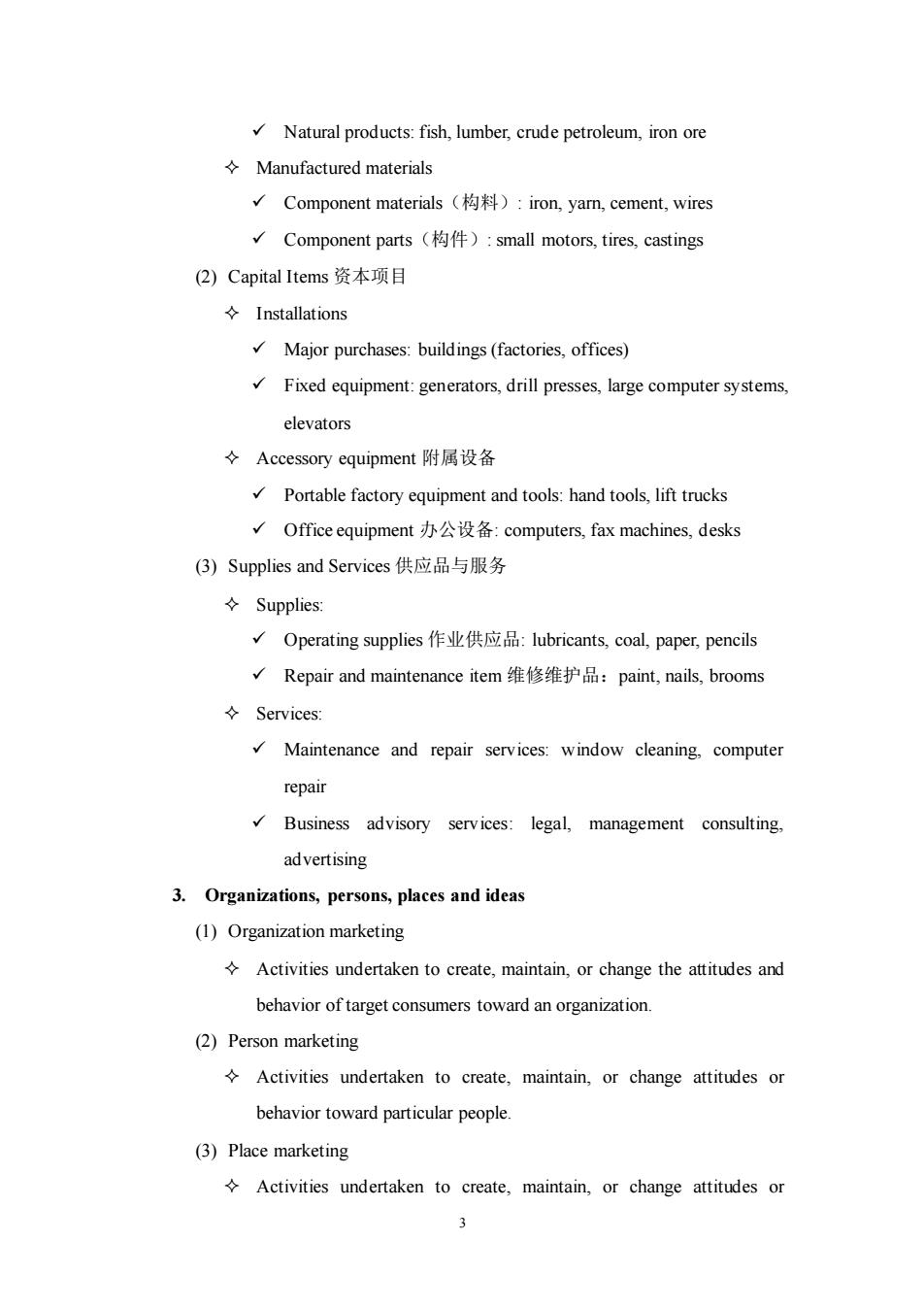
Natural products:fish,lumber,crude petroleum,iron ore Manufactured materials √Component materials(构料):iron,yam,cement,.wires √Component parts(构件):small motors,.tires,castings (2)Capital Items资本项目 ◇Installations Major purchases:buildings(factories,offices) Fixed equipment:generators,drill presses,large computer systems. elevators 令Accessory equipment附属设备 Portable factory equipment and tools:hand tools,lift trucks √Office equipment办公设备:computers,fax machines,.desks (3)Supplies and Services供应品与服务 ◇Supplies, √Operating supplies作业供应品:lubricants,.coal,paper,pencils √Repair and maintenance item维修维护品:paint,.nails,brooms ◇Services: Maintenance and repair services:window cleaning.computer repair Business advisory services:legal,management consulting. advertising 3.Organizations,persons,places and ideas (1)Organization marketing Activities undertaken to create.maintain,or change the attitudes and behavior of target consumers toward an organization (2)Person marketing Activities undertaken to create,maintain,or change attitudes or behavior toward particular people (3)Place marketing Activities undertaken to create,maintain,or change attitudes or 3
3 ✓ Natural products: fish, lumber, crude petroleum, iron ore Manufactured materials ✓ Component materials(构料): iron, yarn, cement, wires ✓ Component parts(构件): small motors, tires, castings (2) Capital Items 资本项目 Installations ✓ Major purchases: buildings (factories, offices) ✓ Fixed equipment: generators, drill presses, large computer systems, elevators Accessory equipment 附属设备 ✓ Portable factory equipment and tools: hand tools, lift trucks ✓ Office equipment 办公设备: computers, fax machines, desks (3) Supplies and Services 供应品与服务 Supplies: ✓ Operating supplies 作业供应品: lubricants, coal, paper, pencils ✓ Repair and maintenance item 维修维护品:paint, nails, brooms Services: ✓ Maintenance and repair services: window cleaning, computer repair ✓ Business advisory services: legal, management consulting, advertising 3. Organizations, persons, places and ideas (1) Organization marketing Activities undertaken to create, maintain, or change the attitudes and behavior of target consumers toward an organization. (2) Person marketing Activities undertaken to create, maintain, or change attitudes or behavior toward particular people. (3) Place marketing Activities undertaken to create, maintain, or change attitudes or
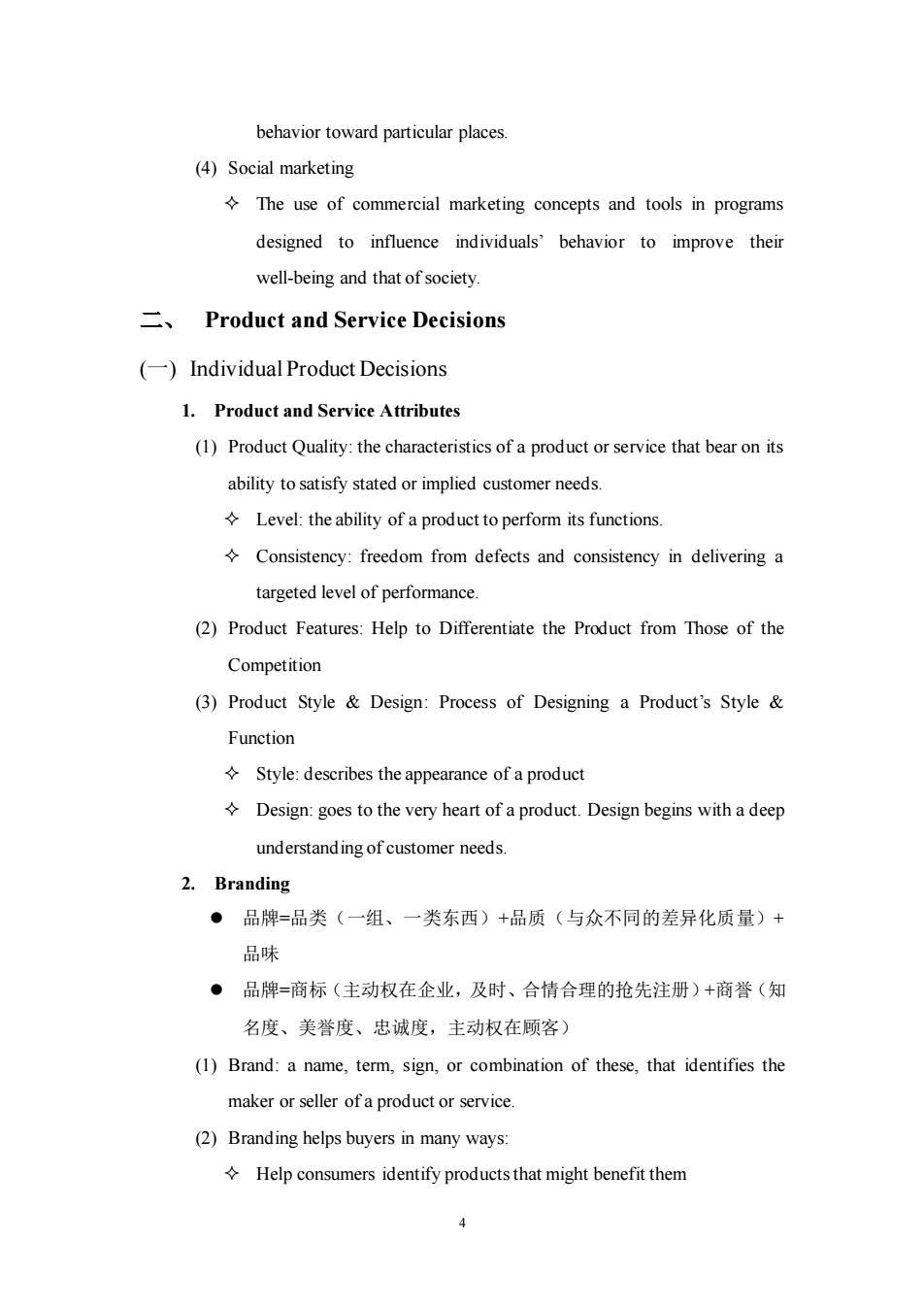
behavior toward particular places. (4)④Social marketing The use of commercial marketing concepts and tools in programs designed to influence individuals'behavior to improve their well-being and that of society. 二、Product and Service Decisions ()Individual Product Decisions 1.Product and Service Attributes (1)Product Quality:the characteristics of a product or service that bear on its ability to satisfy stated or implied customer needs Level:the ability of a product to perform its functions. Consistency:freedom from defects and consistency in delivering a targeted level of performance (2)Product Features:Help to Differentiate the Product from Those of the Competition (3)Product Style&Design:Process of Designing a Product's Style& Function Style:describes the appearance of a product Design:goes to the very heart of a product.Design begins with a deep understanding of customer needs 2.Branding ·品牌=品类(一组、一类东西)+品质(与众不同的差异化质量)+ 品味 ·品牌=商标(主动权在企业,及时、合情合理的抢先注册)+商誉(知 名度、美誉度、忠诚度,主动权在顾客) (1)Brand:a name,term,sign,or combination of these,that identifies the maker or seller of a product or service. (2)Branding helps buyers in many ways: Help consumers identify products that might benefit them
4 behavior toward particular places. (4) Social marketing The use of commercial marketing concepts and tools in programs designed to influence individuals’ behavior to improve their well-being and that of society. 二、 Product and Service Decisions (一) Individual Product Decisions 1. Product and Service Attributes (1) Product Quality: the characteristics of a product or service that bear on its ability to satisfy stated or implied customer needs. Level: the ability of a product to perform its functions. Consistency: freedom from defects and consistency in delivering a targeted level of performance. (2) Product Features: Help to Differentiate the Product from Those of the Competition (3) Product Style & Design: Process of Designing a Product’s Style & Function Style: describes the appearance of a product Design: goes to the very heart of a product. Design begins with a deep understanding of customer needs. 2. Branding ⚫ 品牌=品类(一组、一类东西)+品质(与众不同的差异化质量)+ 品味 ⚫ 品牌=商标(主动权在企业,及时、合情合理的抢先注册)+商誉(知 名度、美誉度、忠诚度,主动权在顾客) (1) Brand: a name, term, sign, or combination of these, that identifies the maker or seller of a product or service. (2) Branding helps buyers in many ways: Help consumers identify products that might benefit them
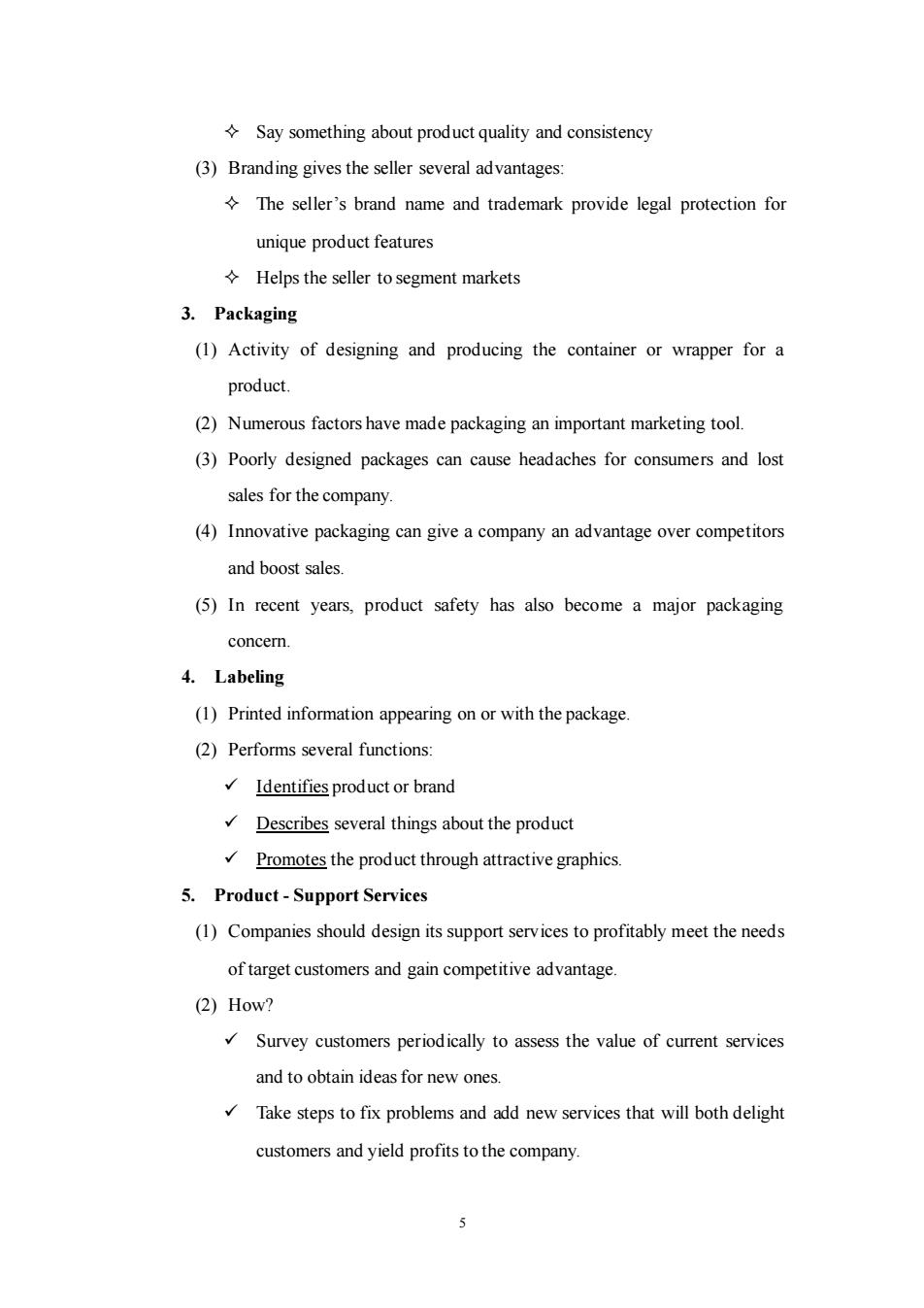
Say something about product quality and consistency (3)Branding gives the seller several advantages: The seller's brand name and trademark provide legal protection for unique product features Helps the seller to segment markets 3.Packaging (1)Activity of designing and producing the container or wrapper for a product. (2)Numerous factors have made packaging an important marketing tool. (3)Poorly designed packages can cause headaches for consumers and lost sales for the company. (4)Innovative packaging can give a company an advantage over competitors and boost sales. (5)In recent years,product safety has also become a major packaging concern. 4.Labeling (1)Printed information appearing on or with the package (2)Performs several functions Identifies product or brand Describes several things about the product Promotes the product through attractive graphics 5.Product-Support Services (1)Companies should design its support services to profitably meet the needs of target customers and gain competitive advantage (2)How? Survey customers periodically to assess the value of current services and to obtain ideas for new ones. Take steps to fix problems and add new services that will both delight customers and yield profits to the company
5 Say something about product quality and consistency (3) Branding gives the seller several advantages: The seller’s brand name and trademark provide legal protection for unique product features Helps the seller to segment markets 3. Packaging (1) Activity of designing and producing the container or wrapper for a product. (2) Numerous factors have made packaging an important marketing tool. (3) Poorly designed packages can cause headaches for consumers and lost sales for the company. (4) Innovative packaging can give a company an advantage over competitors and boost sales. (5) In recent years, product safety has also become a major packaging concern. 4. Labeling (1) Printed information appearing on or with the package. (2) Performs several functions: ✓ Identifies product or brand ✓ Describes several things about the product ✓ Promotes the product through attractive graphics. 5. Product - Support Services (1) Companies should design its support services to profitably meet the needs of target customers and gain competitive advantage. (2) How? ✓ Survey customers periodically to assess the value of current services and to obtain ideas for new ones. ✓ Take steps to fix problems and add new services that will both delight customers and yield profits to the company